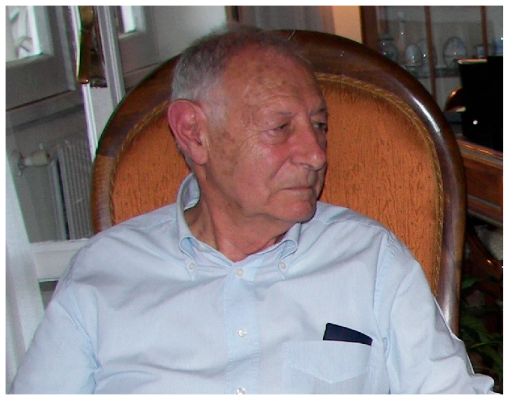The Fine Legacy of Giovanni P. Martelli (1935–2020), a Preeminent Plant Virologist and the Founder of Modern Grapevine Virology
 |
| Giovanni Martelli in Rome in June 2012 relaxing with old friends. |
 |
| Giovanni Martelli in June 2012 on top of Vittorio Emanuele II Monument (Il Vittoriano) in Rome City Center. Behind Giovanni, the Winged Victory Statue on Chariot. |
Author Contributions
Funding
Conflicts of Interest
References
- Rubino, L. Giovanni Paolo Martelli (1935–2020). J. Plant Pathol. 2020, 102, 1–2. [Google Scholar] [CrossRef] [Green Version]
- Martelli, G.P. Available online: https://www.apsnet.org/members/give-awards/awards/Fellows/Pages/GiovanniPMartelli.aspx (accessed on 10 December 2022).
- Hewitt, W.B.; Raski, D.J.; Goheen, A.C. Nematode vector of soil-borne fanleaf virus of grapevines. Phytopathology 1958, 48, 586–595. [Google Scholar]
- Martelli, G.P.; Uyemoto, J.K. Plant virus diseases: Fruit trees and grapevine. In Encyclopedia of Virology, 3rd ed.; Mahy, B.W.J., Van Regenmortel, M.H.V., Eds.; Academic Press: Burlington, MA, USA, 2008; pp. 201–207. [Google Scholar]
- Martelli, G.P.; Quacquarelli, A. The present status of tomato and pepper viruses. Acta Hortic. 1983, 127, 39–65. [Google Scholar] [CrossRef]
- Gallitelli, D.; Mascia, T.; Martelli, G.P. Viruses in artichoke. Adv. Virus Res. 2012, 84, 289–324. [Google Scholar]
- Martelli, G.P.; Castellano, M.A.; Lafortezza, R. An ultrastructural study of fig mosaic. Phytopathol. Mediterr. 1993, 32, 33–43. [Google Scholar]
- Elbeaino, T.; Digiaro, M.; Alabdullah, A.; de Stradis, A.; Minafra, A.; Mielke, N.; Castellano, M.A.; Martelli, G.P. A multipartite single-stranded negative-sense RNA virus is the putative agent of fig mosaic disease. J. Gen. Virol. 2009, 90, 1281–1288. [Google Scholar] [CrossRef]
- Elbeaino, T.; Digiaro, M.; Martelli, G.P. Complete nucleotide sequence of four RNA segments of fig mosaic virus. Arch. Virol. 2009, 154, 1719–1727. [Google Scholar] [CrossRef]
- Martelli, G.P. Fig mosaic disease and associated pathogens. In Virus and Virus-like Diseases of Pome and Stone Fruits; Hadidi, A., Barba, M., Candresse, T., Jelkmann, W., Eds.; APS Press: St. Paul, MN, USA, 2011; pp. 281–287. [Google Scholar]
- Martelli, G.P.; Russo, M. Use of thin sectioning for visualization and identification of plant viruses. In Methods in Virology; Maramorosch, K., Kaprowski, H., Eds.; Academic Press: New York, NY, USA, 1984; Volume 8, pp. 143–224. [Google Scholar]
- Castellano, M.A.; Abou-Ghanem, N.; Martelli, G.P.; Boscia, D.; Savino, V. Cytopathology of two filamentous grapevine viruses and their intracellular identification by gold immunolabelling. J. Plant Dis. Prot. 1995, 102, 23–33. [Google Scholar]
- Martelli, G.P.; Russo, M. Plant virus inclusion bodies. Adv. Virus Res. 1977, 21, 175–266. [Google Scholar]
- Martelli, G.P. Cytochemistry of virus-infected plant cells. In Electron Microscopy of Plant Pathogens; Mengden, K., Lesemann, D.E., Eds.; Springer-Verlag: Berlin, Germany, 1991; pp. 103–117. [Google Scholar]
- Russo, M.; Martelli, G.P. Ultrastructure of turnip crinkle- and saguaro cactus virus-infected tissues. Virology 1982, 118, 109–116. [Google Scholar] [CrossRef]
- Castellano, M.A.; Martelli, G.P.; Savino, P. Virus-like particles and ultrastructural modifications in the phloem of leafroll affected grapevine. Vitis 1983, 22, 23–39. [Google Scholar]
- Castellano, M.A.; Martelli, G.P. Ultrastructure and nature of vesiculated bodies associated with isometric virus-like particles in diseased grapevines. J. Ultrastruct. Res. 1984, 89, 56–64. [Google Scholar] [CrossRef]
- Martelli, G.P. Nematode-borne viruses of grapevine, their epidemiology and control. Nematol. Mediterr. 1978, 6, 1–27. [Google Scholar]
- Martelli, G.P.; Taylor, C.E. Distribution of viruses and their nematode vectors. Adv. Dis. Vector Res. 1989, 6, 151–189. [Google Scholar]
- Martelli, G.P.; Uyemoto, J.K. Nematode-borne viruses of stone fruits. In Virus and Virus-like Diseases of Pome and Stone Fruits; Hadidi, A., Barba, M., Candresse, T., Jelkmann, W., Eds.; APS Press: St. Paul, MN, USA, 2011; pp. 161–170. [Google Scholar]
- Minafra, A.; Hadidi, A.; Martelli, G.P. Detection of grapevine closterovirus A in infected tissue by reverse transcription-polymerase chain reaction. Vitis 1992, 31, 221–227. [Google Scholar]
- Minafra, A.; Hadidi, A. Sensitive detection of grapevine virus A, B, or leafroll-associate III from viruliferous mealybugs and infected tissue by cDNA amplification. J. Virol. Methods 1994, 47, 175–187. [Google Scholar] [CrossRef]
- Saponari, M.; Savino, V.; Martelli, G.P. Seed transmission of olive viruses [Olea europaea L.]. Riv. Fruttic. 2002, 64, 103–105. [Google Scholar]
- Gallitelli, D.; Finetti-Sialer, M.; Martelli, G.P. Anulavirus, a proposed new genus of plant viruses in the family Bromoviridae. Arch. Virol. 2005, 150, 407–441. [Google Scholar] [CrossRef]
- Castellano, M.A.; De Stradis, A.; Minafra, A.; Boscia, D.; Martelli, G.P. Seed transmission of fig latent virus 1. J. Plant Pathol. 2009, 91, 697–700. [Google Scholar]
- Bovey, R.; Gartel, W.; Hewitt, W.B.; Martelli, G.P.; Vuitttenez, A. Virus and Virus-like Diseases of Grapevines. Colour Atlas of Symptoms; Editions Payot: Lausanne, Switzerland, 1980; 183p. [Google Scholar]
- Martelli, G.P.; Boudon-Padieu, E. Directory of infectious diseases of grapevines. Options Méditerr. Series B 2006, 55, 59–75. [Google Scholar]
- Martelli, G.P. Directory of virus and virus-like diseases of the grapevine and their agents. J. Plant Pathol. 2014, 96, 1–136. [Google Scholar]
- Meng, B.; Martelli, G.P.; Golino, D.A.; Fuchs, M. (Eds.) . Grapevine Viruses: Molecular Biology, Diagnostics and Management; Springer: Berlin/Heidelberg, Germany, 2017; 698p. [Google Scholar]
- Martelli, G.P. Termotrapia delle virosi: Nuovi orientamenti. Italia Agric. 1966, 103, 513–528. [Google Scholar]
- Martelli, G.P.; Walter, B. Virus certification of grapevine. In Plant Virus Disease Control; Hadidi, A., Khetarpal, R.K., Koganezawa, H., Eds.; APS Press: St. Paul, MN, USA, 1998; pp. 261–276. [Google Scholar]
- Rowahni, A.; Uyemoto, J.K.; Golino, D.A.; Martelli, G.P. Pathogen testing and certification of Vitus and Prunus species. Annu. Rev. Phytopathol. 2005, 43, 261–278. [Google Scholar] [CrossRef] [Green Version]
- Martelli, G.P.; Agranovsky, A.A.; Bar-Joseph, M.; Boscia, D.; Candresse, T.; Coutts, R.H.A.; Dolja, V.V.; Falk, B.W.; Gonsalves, D.; Jelkmann, W.; et al. The family Closteroviridae revised. Arch. Virol. 2002, 147, 2039–2044. [Google Scholar] [CrossRef]
- Martelli, G.P.; Abou Ghanem-Sabanadzovic, N.; Agranovsky, A.A.; Al Rowahnih, M.; Dolja, V.V.; Dovas, C.I.; Fuchs, M.; Gugerli, P.; Hu, J.S.; Jelkmann, W.; et al. Taxonomic revision of the family Closteroviridae with special reference to the grapevine le33afroll-associated members of the genus Ampelovirus and the putative species unassigned to the family. J. Plant Pathol. 2012, 94, 7–19. [Google Scholar]
- Adams, M.J.; Antoniw, J.F.; Bar-Joseph, M.; Brunt, A.A.; Candresse, T.; Foster, G.D.; Martelli, G.P.; Milne, R.G.; Zavriev, S.K.; Fauquet, C.M. The new plant virus family Flexiviridae and assessment of molecular criteria for species demarcation. Arch. Virol. 2004, 149, 1045–1060. [Google Scholar] [CrossRef]
- Martelli, G.P.; Adams, M.J.; Kreuze, J.F.; Dolja, V.V. Family Flexiviridae: A case study in virion and genome plasticity. Annu. Rev. Phytopathol. 2007, 45, 73–100. [Google Scholar] [CrossRef] [Green Version]
- Russo, M.; Burgyan, J.; Martelli, G.P. Molecular biology of Tombusviridae. Adv. Virus Res. 1994, 44, 381–428. [Google Scholar]
- Martelli, G.P.; Sabanadzovic, S.; Abou-Ghanem Sabanadzovic, N.; Edwards, M.C.; Dreher, T. The family Tymoviridae. Arch. Virol. 2002, 147, 1837–1846. [Google Scholar] [CrossRef]
- Elbeaino, T.; Digiaro, M.; Nicole, M.-E.; Muhlbach, H.-P.; Martelli, G.P. ICTV report consortium. ICTV virus taxonomy profile: Fimoviridae. J. Gen. Virol. 2018, 99, 1478–1479. [Google Scholar] [CrossRef]
- Martelli, G.P. Classification and nomenclature of plant viruses: State of the Art. Plant Dis. 1992, 76, 436–442. [Google Scholar] [CrossRef] [Green Version]
- Martelli, G.P. Plant virus taxa: Properties and epidemiological characteristics. J. Plant Pathol. 1997, 79, 151–171. [Google Scholar]
- International Committee on Taxonomy of Viruses Executive Committee. The new scope of virus taxonomy: Partitioning the virosphere into 15 hierarchical ranks. Nat. Microbiol. 2020, 5, 668–674. [Google Scholar] [CrossRef]
- Murphy, F.A.; Fauquet, C.M.; Bishop, D.H.L.; Ghabrial, S.A.; Jarvia, A.W.; Martelli, G.P.; Mayo, M.A.; Summers, M.D. (Eds.) Virus Taxonomy, Classification, and Nomenclature of Viruses; Archives of Virology, Supplement 10; Springer: Vienna, Austria, 1995; 595p. [Google Scholar]
- Martelli, G.P.; Jelkmann, W. Foveavirus, a new plant virus genus. Arch. Virol. 1998, 143, 1245–1249. [Google Scholar] [CrossRef]
- Martelli, G.P.; Russo, M.; Rubino, L.; Sabanadzovic, S. Aureusvirus, a novel genus in the family Tombusviridae. Arch. Virol. 1998, 143, 1847–1851. [Google Scholar] [CrossRef]
- Rubino, L.; Russo, M.; De Stradis, A.; Martelli, G.P. Tepovirus, a novel genus in the family Betaflexiviridae. Arch. Virol. 2012, 157, 1629–1633. [Google Scholar] [CrossRef] [Green Version]
- Current ICTV Taxonomy Release. Virus Taxonomy: 2021 Release, Rank: Order; Name: Martellivirales. EC 53; ICTV: Online, 2021; Email ratification March 2022 (MSL #37); Available online: https://ictv.global/taxonomy (accessed on 8 August 2022).
- Giampetruzzi, A.; Saponari, M.; Almeida, R.P.P.; Essakhi, S.; Boscia, D.; Loconsole, G.; Saldarelli, P. Complete sequence of the olive-infecting strain Xylella fastidiosa subsp. Pauca De Donno. Genome Announc. 2017, 5, e00569-17. [Google Scholar] [CrossRef]
- Giampetruzzi, A.; Saponari, M.; Loconsole, G.; Boscia, D.; Savino, V.N.; Almeida, R.P.P.; Zicca, S.; Landa, B.B.; Chacon-Diaz, C.; Saldarelli, P. Genome-wide analysis provides evidence on the genetic relatedness of the emergent Xylella fastidiosa genotype in Italy to isolates from Central America. Phytopathology 2017, 107, 816–827. [Google Scholar] [CrossRef] [Green Version]
- Martelli, G.P. Xylella fastidiosa and the olive quick decline syndrome in southern Italy. Arab J. Plant Prot. 2018, 36, 57–63. [Google Scholar] [CrossRef]
Disclaimer/Publisher’s Note: The statements, opinions and data contained in all publications are solely those of the individual author(s) and contributor(s) and not of MDPI and/or the editor(s). MDPI and/or the editor(s) disclaim responsibility for any injury to people or property resulting from any ideas, methods, instructions or products referred to in the content. |
© 2023 by the authors. Licensee MDPI, Basel, Switzerland. This article is an open access article distributed under the terms and conditions of the Creative Commons Attribution (CC BY) license (https://creativecommons.org/licenses/by/4.0/).
Share and Cite
Hadidi, A.; Barba, M.; Rubino, L. The Fine Legacy of Giovanni P. Martelli (1935–2020), a Preeminent Plant Virologist and the Founder of Modern Grapevine Virology. Viruses 2023, 15, 210. https://doi.org/10.3390/v15010210
Hadidi A, Barba M, Rubino L. The Fine Legacy of Giovanni P. Martelli (1935–2020), a Preeminent Plant Virologist and the Founder of Modern Grapevine Virology. Viruses. 2023; 15(1):210. https://doi.org/10.3390/v15010210
Chicago/Turabian StyleHadidi, Ahmed, Marina Barba, and Luisa Rubino. 2023. "The Fine Legacy of Giovanni P. Martelli (1935–2020), a Preeminent Plant Virologist and the Founder of Modern Grapevine Virology" Viruses 15, no. 1: 210. https://doi.org/10.3390/v15010210






